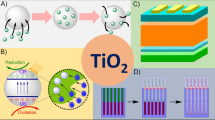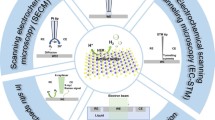Abstract
Previous work has verified the possibility to obtain mechanically, chemically and electrically stable electrodes based on manganese oxide (MnOx) thin films for anodic oxidation of solutions containing the Reactive Violet 5 (RV5) azo dye. To improve the morphological and electrochemical properties of these materials, in this study, a surface modification of the titanium support has been presented. Chemically modified surfaces were obtained by etching titanium substrates in hydrocloridric acid at high temperature. Untreated and modified electrodes were coated sequentially with a RuOx film, as interlayer and a MnOx film obtained by adopting three different techniques including anodic electrodeposition, cathodic electrodeposition and thermal decomposition. Surface morphology, topography and composition of all the electrodes were investigated by profilometric and TOF–SIMS analysis. The electrochemical activity of anodes were first determined by cyclic voltammetry, and then in the treatment of solutions containing the RV5 azo dye, as model pollutant, in undivided cell under galvanostatic conditions. The results show that the surface microstructure modifies substantially the electrochemical response of selected electrodes.









Similar content being viewed by others
References
Izumiya K, Akiyama E, Habazaki H, Kawashima A, Asami K, Hashimoto K, Kumagai N (1997) Surface activation of manganese oxide electrode for oxygen evolution from seawater. J Appl Electrochem 27:1362–1368
Das D, Samaddar PR, Sen PK, Das K (2008) Oxidation of some aliphatic polyols on anodically deposited MnO2. J Appl Electrochem 38:743–749
Nakayama M, Shamoto M, Kamimura A (2010) Surfactant-induced electrodeposition of layered manganese oxide with large interlayer space for catalytic oxidation of Phenol. Chem Mater 22:5887–5894
Roche I, Chaînet E, Chatenet M, Vondrák J (2008) Durability of carbon-supported manganese oxide nanoparticles for the oxygen reduction reaction (ORR) in alkaline medium. J Appl Electrochem 38:1195–1201
Cheng H, Scott K (2010) Carbon-supported manganese oxide nanocatalysts for rechargeable lithium-air batteries. J Power Sources 195:1370–1374
Jacob GM, Zhitomirsky I (2008) Microstructure and properties of manganese dioxide films prepared by electrodeposition. Appl Surf Sci 254:6671–6676
Hua M, Zhang S, Pan B, Zhang W, Lv L, Zhang Q (2012) Heavy metal removal from water/wastewater by nanosized metal oxides: a review. J Hazard Mater 211–212:317–331
Fathy NA, Shaymaa E, El-Shafey SE, Ola I, El-Shafey OI, Wael S, Mohamed WS (2013) Oxidative degradation of RB19 dye by a novel γ-MnO2/MWCNT nanocomposite catalyst with H2O2. J Environ Chem Eng 1:858–864
Chen CY, Wang SC, Tien YH, Tsai WT, Lin CK (2009) Hybrid manganese oxide films for supercapacitor application prepared by sol–gel technique. Thin Solid Films 518:1557–1560
Chou SL, Cheng FY, Chen J (2006) Electrodeposition synthesis and electrochemical properties of nanostructured γ-MnO2 films. J Power Sources 162:727–734
Nam KW, Kim KB (2006) Manganese oxide film electrodes prepared by electrostatic spray deposition for electrochemical capacitors. J Electrochem Soc 153:A81–A88
Djurfors B, Broughton JN, Brett MJ, Ivey DG (2005) Electrochemical oxidation of Mn/MnO films: formation of an electrochemical capacitor. Acta Mater 53:957–965
Xia H, Xiao W, Lai MO, Lu L (2009) Facile synthesis of novel nanostructured MnO2 thin films and their application in supercapacitors. Nanoscale Res Lett 4:035–1040
Xia H, Lai MO, Lu L (2011) Nanostructured manganese oxide thin films as electrode material for supercapacitors. JOM 63:49–54
Sotgiu G, Foderà M, Marra F, Petrucci E (2014) Production and characterization of manganese oxide-based electrodes for anodic oxidation of organic compounds. Chem Eng Trans 41:115–120
Moosvi S, Keharia H, Madamwar D (2005) Decolourization of textile dye Reactive Violet 5 by a newly isolated bacterial consortium RVM 11.1. World J Microbiol Biotechnol 21:667–672
Jain K, Shah V, Chapla D, Madamwar D (2012) Decolorization and degradation of azo dye - Reactive Violet 5R by an acclimatized indigenous bacterial mixed cultures-SB4 isolated from anthropogenic dye contaminated soil. J Hazard Mater 213–214:378–386
Cǎilean D, Teodosiu C, Brînzǎ F (2009) Studies regarding advanced processes used for reactive dyes removal from textile effluents. Environ Eng Manag J 8:1045–1051
Khare UK, Bose P, Vankar PS (2007) Impact of ozonation on subsequent treatment of azo dye solutions. J Chem Technol Biotechnol 82:1012–1022
Chung YC, Chen CY (2009) Degradation of azo dye reactive violet 5 by TiO2 photocatalysis. Environ Chem Lett 7:347–352
Roy Choudhury AK (2006) Textile preparation and dyeing. Science Publishers, Enfield
Pinheiro HM, Touraud E, Thomas O (2004) Aromatic amines from azo dye reduction: status review with emphasis on direct UV spectrophotometric detection in textile industry wastewaters. Dyes Pigments 61:121–139
Jüttner K, Galla U, Schmieder H (2000) Electrochemical approaches to environmental problems in the process industry. Electrochim Acta 45:2575–2594
Yu X, Zhou M, Hu Y, Groenen Serrano K, Yu F (2014) Recent updates on electrochemical degradation of bio-refractory organic pollutants using BDD anode: A mini review. Environ Sci Poll Res 21:8417–8431
Recio FJ, Herrasti P, Sirés I, Kulak AN, Bavykin DV, Ponce-De-León C, Walsh FC (2011) The preparation of PbO2 coatings on reticulated vitreous carbon for the electro-oxidation of organic pollutants. Electrochim Acta 56:5158–5165
Ciríaco L, Santos D, Pacheco MJ, Lopes A (2011) Anodic oxidation of organic pollutants on a Ti/SnO2-Sb2O4 anode. J Appl Electrochem 41:577–587
Martinez-Huitle CA, Panizza M (2011) Application of PbO2 anodes for electrochemical wastewater treatment. In: Singh VG (ed) Applied electrochemistry. Publisher, Nova Science, pp 269–300
Panizza M (2010) Importance of electrode material in the electrochemical treatment of wastewater containing organic pollutants. In: Comninellis C, Chen G (eds) Electrochemistry for the environment. Springer, New York, pp 25–54
Candido L, Ponciano Gomes JAC (2011) Evaluation of anode materials for the electro-oxidation of ammonia and ammonium ions. Mater Chem Phys 129:1146–1151
Montanaro D, Petrucci E, Merli C (2008) Anodic, cathodic and combined treatments for the electrochemical oxidation of an effluent from the flame retardant industry. J App Electrochem 38:947–954
Kraft A (2008) Electrochemical water disinfection: a short review. Platin Met Rev 52:177–185
Jeong J, Kim C, Yoon J (2009) The effect of electrode material on the generation of oxidants and microbial inactivation in the electrochemical disinfection processes. Water Res 43:895–901
Petrucci E, Di Palma L, De Luca E, Massini G (2013) Biocides electrogeneration for a zero-reagent on board disinfection of ballast water. J Appl Electrochem 43:237–244
Montanaro D, Petrucci E (2009) Electrochemical treatment of Remazol Brilliant Blue on a boron-doped diamond electrode. Chem Eng J 153:138–144
Acknowledgments
L.T. gratefully acknowledges Fondazione Roma and INFN for financial support.
Author information
Authors and Affiliations
Corresponding author
Rights and permissions
About this article
Cite this article
Sotgiu, G., Tortora, L. & Petrucci, E. Influence of surface roughening of Titanium substrate in the electrochemical activity of Manganese oxide thin film electrode in anodic oxidation of dye-containing solutions. J Appl Electrochem 45, 787–797 (2015). https://doi.org/10.1007/s10800-015-0827-y
Received:
Accepted:
Published:
Issue Date:
DOI: https://doi.org/10.1007/s10800-015-0827-y




